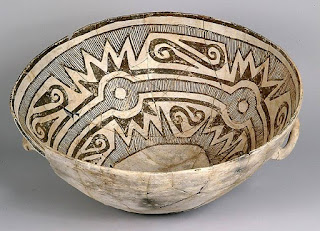The Ancestral Puebloans were an ancient Native American culture that spanned the present-day Four Corners region of the United States, comprising southeastern Utah, northeastern Arizona, northwestern New Mexico, and southwestern Colorado. It is believed that the Ancestral Puebloans developed, at least in part, from the Oshara Tradition, who developed from the Picosa culture. They lived in a range of structures that included small family pit houses, larger structures to house clans, grand pueblos, and cliff-sited dwellings for defense.
The Ancestral Puebloans possessed a complex network that stretched across the Colorado Plateau linking hundreds of communities and population centers. They held a distinct knowledge of celestial sciences that found form in their architecture. The Kiva, a congregational space that was used chiefly for ceremonial purposes, was an integral part of this ancient people's community structure.
In contemporary times, the people and their archaeological culture were referred to as Anasazi for historical purposes, a name which was given them by the Navajo, who were not their descendants. Reflecting historic traditions, the term was used to mean "ancient enemies," and contemporary Puebloans do not want this term used.
Archaeologists continue to debate when this distinct culture emerged. The current consensus, based on terminology defined by the Pecos Classification, suggests their emergence around the 12th century BC, during the archaeologically designated Early Basketmaker II Era. Beginning with the earliest explorations and excavations, researchers identified Ancestral Puebloans as the forerunners of contemporary Pueblo peoples.
Three UNESCO World Heritage Sites located in the United States are credited to the Pueblos: Mesa Verde National Park, Chaco Culture National Historical Park and Taos Pueblo.
Etymology
Pueblo, which means "village" in Spanish, was a term originating with the Spanish explorers who used it to refer to the people's particular style of dwelling. The Navajo people, who now reside in parts of former Pueblo territory, referred to the ancient people as Anaasází, an exonym meaning "ancestors of our enemies," referring to their competition with the Pueblo peoples. The Navajo now use the term in the sense of referring to "ancient people" or "ancient ones".
Hopi people used the term Hisatsinom, meaning ancient people, to describe the Ancestral Puebloans
The unanswered mysteries of the Anasazi
by Ivan
The great American southwest is considered by many as a place of extremes, ancient people, spirits and legends that even today, inhabit the region. Thousands of years ago, an ancient culture flourished in the region and left amazing footprints in the sub-American continent, giant cities, dwellings in the cliffs and ceremonial chambers called kivas, were found, and all of them belonged to the Anasazi. Even today, there are people who firmly believe in these stories, and that the spirits of this ancient culture still inhabit the lands.
The great American southwest is considered by many as a place of extremes, ancient people, spirits and legends that even today, inhabit the region. Thousands of years ago, an ancient culture flourished in the region and left amazing footprints in the sub-American continent, giant cities, dwellings in the cliffs and ceremonial chambers called kivas, were found, and all of them belonged to the Anasazi. Even today, there are people who firmly believe in these stories, and that the spirits of this ancient culture still inhabit the lands.
Today most of the world’s population lives in cities surrounded by a man-made environment. But many still believe in another world, full of spirits and ancient magic, a world that can be reached through mystical experiences and legends passed on from generation to generation. But how real are these stories we hear about? The region called “Four Corners” well-known by the confluence of four states: Arizona, Utah, Colorado and New Mexico is indigenous to the land of the ancient Anasazi and other great ancient cultures.
In 1897 a rancher looking for cattle that had strayed from a herd, made a surprising discovery: the ancient cliff dwellings in Colorado. The spectacular buildings and artifacts were tangible evidence of an advanced civilization that had lived in the area and disappeared. In the following years, more great discoveries were made as similar structures were found in Utah and Arizona.
The incredible discoveries baffled researchers and historians, buildings that had never before been seen or imagined in the region were found, buildings that support of up to five stories were discovered, something that was considered unusual for todays archaeologists. One of the structures at the archaeological site, which later would be called Pueblo Bonito, contains over 650 rooms.
Interestingly, 20 million years ago, Chaco Canyon was the center of a large Sea. After the sea withdrew, the only thing that was left was a parched desert. Without water, the primary element for life, how could this ancient civilization have flourished in the region? And most importantly, why would they build their cities in such a “lifeless” place? This is just one of many disturbing mysteries that archaeologists have not been able to answer.
Samples taken from the wood indicate that the material originated form elsewhere in the region, some of the pieces of wood originated from distances of over 50 miles. For the cutting and carving process, the ancient builders only used stone axes. The ancient people of Chaco did not have carts or horses to transport the timber, so how did they transport their building materials?
Archaeologists have placed the Anasazi between 900 and 1250 AD. There is no doubt that the residents of these incredible ancient structures are long gone, but what happened to them? Why did they vanish like many other great civilization in the Americas? Was it a natural disaster that made them leave their home? And if so, where did they go to?






















